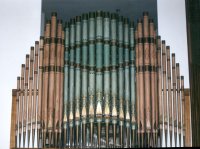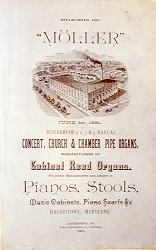  The Nineteenth Century
|
The Organ BusinessAfter the Revolution, business and professional lives in the newly-formed United States of America returned to normal - - "normal" for a frontier society, that is. As the newly-formed nation began to develop and grow, the cities on its east coast lead the way into the new century in all areas of life. Throughout the nineteenth century, political, economic and cultural leadership moved across the continent in a westerly direction, and the "business" of building organs was no exception. In the early years of the nineteenth century, it continued as it had before the Revolution.
Even though the nature of the organ in the United States remained essentially English, the business of building the instruments certainly became independent. Of course, without the possibility of imports, local builders were able to concentrate on improving their own work and meeting the English standards, which they proceeded to do quite well. Additionally, the Industrial Age changed the way the business of organ building was conducted in the United States as it did in England, France and Germany. By the middle of the nineteenth century, you can safely talk about a builder as a "firm," or even a "factory." I don't mean to tell you that the independent builder working in a small shop with only one or two assistants completely disappeared. You will find people working like that even today. The important element here is the appearance of the new way of doing business - - in a large, centrally-controlled organization that could do ten, twenty, or thirty times the work of a single artisan working alone. The nineteenth century saw the birth of the "factory" organ both in the United States and abroad, and you will find pages of this tutorial that talk about specific organ-building firms as well as specific instruments. It's all part of the history of the organ in the United States in the nineteenth century.
For example, on page 6 of this particular brochure, the description of an instrument built for the First Presbyterian Church, Shamokin, Pennsylvania says it has "1031 pipes, 22 Stops." The stoplist at the bottom of the same page, however, lists only 16 speaking stops. The other six stops -- numbered quite precisely on the list -- include the couplers, the bellows signal, the tremolo and a pedal check. Not what we would expect in a "II/22" organ, to use the modern shorthand description. In this sort of advertising description, Möller was actually somewhat conservative in counting stops. They didn't count the composition pedals or the Balanced swell pedal, listed and numbered separately under the heading "Pedal Movements." Here's an example from a publication by Hook & Hastings, a catalog of medium-sized church organs, published around 1905.221 The instrument described on this page is their model 17D, described as an organ of three manuals and 43 registers. Move your mouse pointer over the image, and you'll see the most unusual "register" highlighted. Although numbering the bench seems particularly egregious, other companies as well routinely numbered each coupler and each combination pedal in lists of this type. Today we would refer to this as a "III/27" organ, because only the first twenty-seven items are its speaking stops. Now don't worry about this kind of detail as you prepare for the next quiz. This information is here as an illustration, not so you can memorize it and be ready to repeat it on the next quiz. I simply want you to remember that not all you read in nineteenth-century publications is what you might think at first glance. It's important to read critically and think seriously about the information you run across, especially when that information is meant to help promote and sell a product. CharacteristicsIt's important to think about changes in the ways organs were built in the nineteenth century, but it's more important to think about their product -- the organs themselves. The nature of the instruments also changed over the course of the first half of the nineteenth century, and, as you might expect, many of these gradual changes paralleled those in England and Europe. The nineteenth-century organ was both larger and louder than its eighteenth-century predecessor. Although its use did not change, there was an expansion in the concept of what an organ should do, and where one might be installed. Following the English tradition, the early nineteenth-century organ in the United States was first and foremost an instrument used to accompany singing in church. The basic pattern of the English church organ was first expanded through the addition of pedal stops, then through the addition of new colors. In both these ways, as in the adoption of the C compass before the middle of the century, the organ in the United States and in England began to absorb characteristics of German instruments. By the middle of the century, as society became more stable, new public buildings -- concert halls, lodges, theaters -- included organs. By the end of the century, as business became even more profitable, the homes of the wealthy often included provisions for the installation of an organ. As you study study the nineteenth-century American organ, then, you should consider each one from these standpoints.
As you read the descriptions of specific instruments on the accompanying pages, think about these questions. Ask yourself about the sound a given disposition would produce, or ask your self how the placement of the instrument in the room affects its sound. As you read descriptions of instruments, ask yourself how it would have been described by its builder, its purchaser, the organist, or the listener. Where it has been possible to do so, I've included comments of this type on the accompanying pages. For the first time in this class, you're studying instruments of the type you can find nearby -- not half the world away. With a little bit of effort, you can even study some of these instruments first-hand, not on paper or on line. BuildersThe first half of the nineteenth-century -- up to the beginning of the Civil War -- was a time of consolidation, growth and internal development throughout the United States. Many builders began work in the early years of the century, producing fine instruments that in some instances have survived to the present day. Although some of these people built instruments for only a short time, others established firms that continued to produce musical instruments throughout the nineteenth century and into the twentieth. From both early and late in the century, there are names which should strike a note of recognition when you hear them. Even though this tutorial is meant to be a survey -- a type of course that typically skims the surface and doesn't dive below it very often -- it doesn't include information on each and every builder from the nineteenth century. In fact, it doesn't even mention some of them. It concentrates on only one nineteenth-century builder (the Hook firm of Boston), at the almost total exclusion of others. But -- and this is a big "but" -- I don't want you to misunderstand. I think it's also important to look at instruments by other builders as well. So you'll find descriptions of organs by Henry Erben, by the Pilchers, by Jardine -- by any number of other builders. The "story" of the Hook firm is here as an example of one among many. I hope you will continue to learn more about each of the other builders as you encounter their instruments, but for the purposes of this class, you have only to learn some details of the Hook firm and their instruments. © 2000 AD James H. Cook |
 The development of the organ factory brought with it the development of advertising for the industry, and many libraries and even church archives hold copies of various catalogs and brochures published by nineteenth-century organ firms. The photograph to the right is of the front cover of one such sales brochure, published in 1891.
The development of the organ factory brought with it the development of advertising for the industry, and many libraries and even church archives hold copies of various catalogs and brochures published by nineteenth-century organ firms. The photograph to the right is of the front cover of one such sales brochure, published in 1891.